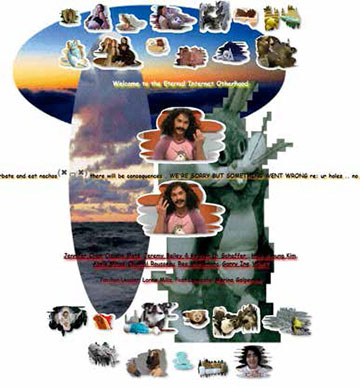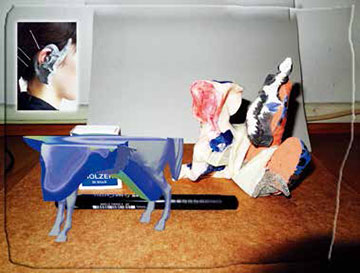THE WRONG—NEW DIGITAL ART BIENNALE
| May 6, 2014 | Post In LEAP 26

The use of the term “digital art” in “The Wrong— New Digital Art Biennale” is intriguing. Evoking a medium specificity that recalls the often maligned, dated domain of new media art, but suggesting a broader criteria for inclusion and an expanded set of concerns, it may well be seen as symptomatic of the difficulties posed in categorizing the diverse range of art practices that now occur—at least partially— online.
Digital art is without a doubt undergoing a period of expansion and transition. In October of last year, the art auction house Phillips presented the world’s first digital art auction, “Paddles On!”, a move that seemed both forward thinking and inevitable. A comparable move towards legitimation seems to be occurring with The Wrong, which adopts a biennale structure and adapts it to an online platform. Helmed by David Quilles Guilló, the biennale is organized into 30 artist-curated pavilions and includes over 300 artists. In addition to the curated pavilions is something called the Homeostasis Lab, a chaotic-looking pavilion that was open to submissions, and 11 physical gallery spaces from around the world that were transformed into “Wrong Embassies” for the duration of the event, blurring the already murky boundaries between online and IRL practices.
By situating The Wrong within a biennale context, Guilló invites a tension between an endorsement of digital art’s growing prominence and a subversion of the biennale model. Subjected to the sometimes anarchic playfulness of net-based practices, The Wrong is certainly unlike any other biennale in content and character, but in taking digital art out of its native context of blogs, social media and one-off curatorial initiatives, it runs the risk of domesticating a set of practices that operate via the productive interchange between art and non-art contexts.

Otherhood,” curated by Lorna Mills
A more practical consideration, and one that is increasingly shared by biennales and large-scale exhibitions of kinds, is of how to organize such a massive amount of art. The use of pavilions, which mimics a typical biennale setup, proves to be an elegant solution, with each portal representing the specific interests of the curating artist, and providing a sense of variety amidst massive amounts of data.
A good example is the largely excellent Sara Lundy-curated “Chambers” pavilion. Featuring artists such as Dump.fm-affiliate Tom Moody and Bunny Rogers, the pavilion’s homepage is laid out in austere black and white, and using a blueprint-like format, links to the individual“sound rooms” in which each artist’s work is contained. The majority of the contributions are considerably more restrained than the stereotypical information overload of internet-based artists, such as Leah Beeferman’s Empty space (42/40/43/78↑, 77/74/73↑ / 15↑) (2013), a blank blue screen and an ambient sound piece that aims for immersion and contemplation of a kind more typically associated with physical gallery spaces. Similarly, Bunny Rogers and Krist Wood both contribute pieces titled Corners (2013). Rogers’ is a digital line drawing of a chair in the corner of a room with a sing-song MIDI file playing in the background; click through and you’ll be taken to Wood’s piece, a photograph of a little girl, back facing the camera, standing in the corner of a room while a recording of a music box plays. Both are nostalgic in a certain sense, but the ways in which they are nostalgic—one representing an authentic, analog, and properly historical sense of nostalgia, the other representing something of an inauthentic primitivism—are very different.
One of the more high profile pavilions is Anthony Antonellis’ “Young Internet Based Artists.” Antonellis achieved a brief moment of popular consciousness last year when he had a RFID chip containing an artwork and readable with a mobile phone inserted into his hand. “Young Internet Based Artists” is cleanly and functionally designed, containing a mix of .gif and video works, many of which, as the pavilion’s title suggests, fetishize youth and the figure of the young artist alone at their computer. There is a welcome diversity and creativity to the works’ presentations, which range from simple standalone videos to Debora Delmar Corporation’s vast Prezi presentation of an array of creatively juxtaposed stock images. There’s a fair dose of wry humor too—Hunter Payne’s The Public Internet Control Switch is a simple drawing of a light switch that when clicked on makes the screen go blank. With little uniting its works except for their being made by, yes, young artists based on the internet, the pavilion is something of a mixed bag, but its most interesting contributions are those that in some way acknowledge the IRL existences of the artist and viewer. Jan Robert Leegte achieves this to an unsettling effect with Random Selection in Proximity, a work that automatically detects your location and then provides a Google Street View image of it.
Eschewing clean and functional design is “The Eternal Internet Otherhood,” curated by Lorna Mills. With a front-page aesthetic that recalls the bygone era of amateur web design represented by Geocities, including the use of the Comic Sans font, scrolling text and deliberately low resolution color images, the pavilion focuses on works that trouble the boundaries of selfhood, and those between our virtual and our real-life selves. Most notably, Jeremy Bailey and Kristen D. Schaffer contribute a video demonstrating an “augmented reality effect” that grafts a brightly colored unicorn’s facial features onto Schaffer’s face, highlighting technology’s not-quite newfound potential to allow you to be someone other than yourself. Exploring an equally messy aesthetic is the Andrew Benson-curated “Plastic yet still in-between.” The pavilion is a succinct testament to the hazy boundaries often separating online underground music scenes from the world of digital art, and features work from Sean Bowie (Teams), Jacob Ciocci, and Jónó Mí Ló that are heavy on sonic and visual manipulation.

Digital image, online, pavilion iMOCA
Yet, much of The Wrong’s most successful art is that which makes an effort to find routes out of overdone glitch effects and early internet platform nostalgia, work that looks less like the internet as we knew it and more like the hybridized space we now constantly inhabit, where being “connected” is a given. iMOCA, curated by Michael Staniak, does this in an especially savvy way. Its title referring perhaps to Los Angeles’ Museum of Contemporary Art, the virtual pavilion’s homepage depicts a floor plan in which each room houses the work of a separate artist (with a gift shop in the center), while its user-friendly interface and upbeat title allude to the increasing digitalization of museums— it’s not hard to imagine an institution like MOCA using a similar interface as an online platform to explore the museum from the comfort of your laptop or iPad.
One problem that commonly afflicts digital art, especially outside of an institutional context, is quality control. The Wrong is hardly immune from this, presenting a vast amount of work, much of it with a very similar, some might say clichéd, aesthetic, that would take hours upon hours to comb through properly. In many ways, this is the point. The Wrong represents one possible outcome of the horizontalizing effect of the internet on the art object, where the art object no longer needs an institutional context to be understood as art and most of its viewers might not even know that it is art.
Packaging The Wrong in a format that is borrowed from the institutionally legitimizing context of the art world, as subversive and droll as its “biennale” label is presumably intended to be, lends its curation a somewhat schizophrenic quality. That some of the artists featured also make physical work that is exhibited in real galleries, while others don’t, suggests an unspoken divide between pure digital art and the typically gallery-based work that is often referred to as “post-internet.” Drawn on the one hand to the legitimation that increased integration with the art world brings to digital art, and on the other hand hostile to its hierarchical nature, The Wrong is nevertheless afflicted with a more basic divide, between some very good art and some very bad art.


